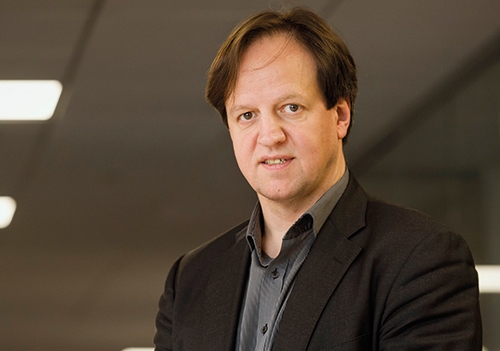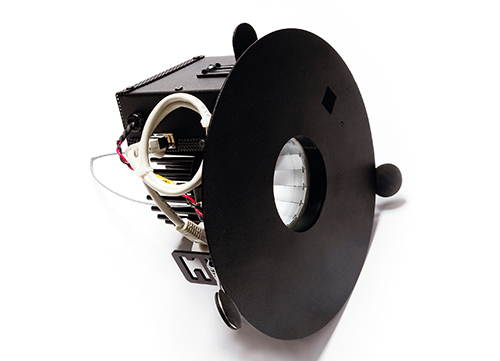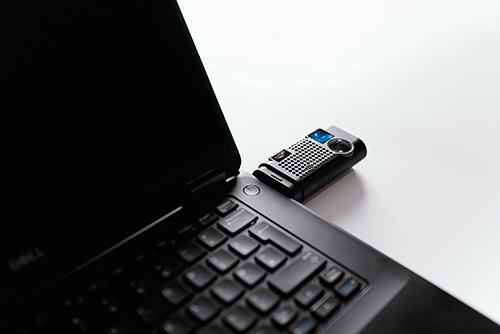Fraunhofer IPMS’s LiFi Gigadock and Hotspot systems use direct line of sight to deliver fast data rates
LiFi – standing for light fidelity – promises much as a way of transmitting data. With speeds in excess of 100Gb/s conceived, all communicated through LED lighting, the technology seems to be superior in many ways to the slower WiFi networks based on radio frequency. What’s more, LiFi is now a commercial reality, with Edinburgh-based firm, PureLiFi, offering a LiFi USB dongle and a LiFi-integrated luminaire, but there is still a long way to go until every LED light is produced with LiFi capability. Different concepts that make use of the technology are also being suggested, including those from teams at the Fraunhofer Institute for Photonic Microsystems IPMS and Eindhoven University of Technology.
The idea behind LiFi was developed in the early 2000s after Professor Harald Haas, director of the LiFi Research and Development Centre in Edinburgh and CSO of PureLiFi, realised that an issue existed with the amount of radio bandwidth currently available.
‘It was exactly at the cusp where we went from mobile telephones to multimedia mobiles,’ Haas explained. ‘The full extent of the mobile internet wasn’t clear at the time. It was clear however that if mobile multimedia took off then the bandwidth in the radio domain wouldn’t be sufficient. That prediction is now coming true; we are running out of bandwidth, running out of radio spectrum.’
Haas and his colleagues began exploring how much data could be transmitted using the high brightness white LEDs that were being developed for solid-state lighting applications at the time – similar to how television remote controls transmit tiny amounts of data in the infrared.
‘The breaking point was where we used a form of modulation that had already successfully been used in radios,’ said Haas. ‘We turned a disadvantage of orthogonal frequency division multiplexing (OFDM) – the high peak to average power ratio also referred to as the crest factor – into an advantage for intensity modulation with LEDs. We had the first proof of concept paper in 2006; from then onwards, all the hero data-rate experiments in that field have been based on OFDM.’

Professor Harald Haas is considered to be the ‘father of LiFi’, having coined the term in 2011
Data transmission rates have since gone from being a couple of megabits to multiple gigabits per second, according to Haas, who with his colleagues was recently able to achieve 11Gb/s using a single LED. ‘This is faster than the soon to be commercialised next generation WiFi system, WiGig,’ he remarked. ‘OFDM has been the instrumental algorithm on the data encoding side to achieve these data rates.’ Haas also believes that data rates of 50Gb/s are easily conceivable in the near future through combining multiple LEDs of different wavelengths.
Haas coined the term ‘LiFi’ at his 2011 TED Global Talk, where he introduced the idea of receiving wireless data from every light. ‘We conceive and have introduced LiFi as a cellular networking technology for wireless communication using light,’ he said. ‘We have the opportunity to reach data rates in excess of 100Gb/s from these light sources.’
LiFi transmits data through the extremely rapid intensity modulation of LEDs, which can be received by photo-sensitive detectors and demodulated into electrical signals that are readable by devices. These modulations occur at megahertz frequencies and are therefore imperceptible to the human eye.
Haas uses frequencies above 1MHz and up to 1GHz, depending on the source, which gives protection against ambient light that can be filtered out. ‘Even in the strongest 70,000 lux sunlight conditions, there will be negligible degradation of the LiFi signal,’ he said. The LED can also be dimmed to the point where it appears off while still providing full functionality – a feature that ensures the technology can still be used at night.
Not only does LiFi enable data transmission rates much higher than those of WiFi, but it also grants additional bandwidth capacity by providing 1,000 times more available spectrum than the radio domain, making it suitable to address the modern multimedia demands of mobile internet.
‘LiFi can provide nearly unlimited bandwidth,’ commented Dr Alexander Noack, team leader for LiFi technology development at Fraunhofer IPMS. ‘While certain radio frequency bands, such as the ISM [industrial, scientific and medical] and military bands cannot be used by the public, nothing like this exists yet for light. The complete light spectrum can be used, from the UV to infrared, enabling a huge amount of bandwidth.’
The optical properties of a LiFi signal prevent it from passing through opaque objects, such as walls or clothing; however, this potential disadvantage also makes it secure, as the light signal cannot be intercepted from outside the room where the source is emitting. A recent qualitative study performed by Haas and his colleagues – for which they won an award at the International Conference on Communications – showed that LiFi’s secrecy capacity is 20 times higher than WiFi’s.
The first commercial LiFi system, a desktop transceiver called ‘Li-1st’, was demonstrated by Haas and his firm PureLiFi at the 2014 Mobile World Congress in Barcelona. Since then the company has developed the LiFi-X, a smaller, more advanced system in the form of a USB dongle that receives signals from a LiFi-integrated LED luminaire in the ceiling.
The ceiling module is bidirectional; a unique feature of LiFi is that it can transmit in both directions. The LiFi-X also doesn’t need direct line of sight, as it works using surface reflections – if a smartphone with a receiver was pointing at the floor, it could still pick up enough reflected signal from a transmitter in the ceiling to maintain a good communication link, according to Haas.
The current LiFi-X module is the third generation of a system on an aggressive roadmap towards miniaturised LiFi technology – a move that will ultimately lead to its increased uptake, according to Haas, who believes mass-market adoption will come with further miniaturisation.

Lucibel’s ceiling luminaire delivers an optical LiFi signal to up to eight devices
The LiFi-X enables a person to move between multiple LiFi-integrated LED luminaires without suffering loss in connectivity. Alternatively, two people in different rooms could also receive different data on exactly the same frequency without interrupting each other’s signal. ‘We can re-use the same spectrum in a very dense way, and this is why we achieve these unprecedented data densities,’ commented Haas.
PureLifi currently has an ongoing partnership with French firm Lucibel, which has developed an industrial LiFi-integrated LED luminaire. The luminaire, combining Lucibel’s LiFi USB key that uses the same technology as PureLifi’s LiFi-X, can be accessed by eight separate users and currently offers bidirectional data communication up to 42Mb/s, with data rates much faster than WiFi expected in the future.
‘Our partnership with Lucibel … allows us to accelerate LiFi’s real world commercial implementation,’ said Alistair Banham, CEO of PureLiFi. ‘This partnership between two innovative companies has resulted in a world-first LiFi integrated luminaire, and this is a step towards LiFi’s future as a 5G technology.’
The Fraunhofer Institute for Photonic Microsystems IPMS is taking an alternative approach to delivering LiFi. Its Gigadock and Hotspot systems use direct line of sight setups to deliver faster data rates, the Gigadock operating at around 12.5Gb/s, while Hotspot gives 1Gb/s.
The LiFi Gigadock is an optical docking station that can be used to replace short cables and connectors over short distances, for example in board-to-board communication scenarios in electrical circuits. Measuring only 5 x 5mm, the Gigadock transceiver can easily be soldered onto a PCB, according to Noack.
The Gigadock is able to reach distances approaching one metre, and the Fraunhofer institute is looking to make it immune to vibrations, shocks, rotation and general movement. The institute also has plans to increase the speeds of the Gigadock to 100Gb/s in the future.

PureLiFi’s LiFi-X contains a photodetector and an infrared LED for receiving and delivering LiFi signals
The LiFi Hotspot instead enables a private, high-speed network to be established over distances up to 30 metres. As with the LiFi-X, the data exchange of the Hotspot can be bidirectional and is limited to a defined area, making it possible to use the full bandwidth of each LiFi link without interfering with other Hotspots in the network.
‘The Hotspot could be used in an open office environment where people are sitting around a table and wish to have a high data rate,’ explained Noack. ‘Everyone would have a dedicated private connection and could change connection whenever they want while maintaining a high data rate.’
Fraunhofer IPMS is not looking to replace WiFi, according to Noack, but there are situations where they see it used to complement other communication formats. It also envisions LiFi being used to transfer data in scenarios where closed equipment housing is required, such as in the operating room or in underwater environments.
LiFi everywhere
According to Haas, the application space of LiFi is one of the technology’s most exciting areas. ‘Everywhere where there is a light, including cars, trains, planes, satellites and underwater vehicles, there is now communication capability,’ he said. ‘This is so important, as we are now at the start of the fourth industrial revolution, which is all about a data-centric economy.’
The future of Industry 4.0 will require secure, affordable, high-capacity connectivity – three components that LiFi is set to deliver. ‘It will create the underlying fabric of the future of wireless connectivity,’ Haas continued. ‘With the autonomous car, smart buildings and smart cities, we are creating more connected environments that help us save energy and make our time more efficient.’
Haas continued by explaining how light will be increasingly used to provide services and capabilities in the future, including those such as motion monitoring, occupancy sensing and smart building control. ‘LiFi will be a key enabler for hundreds and thousands of these services,’ he said. ‘We may have seen big things with the smartphone, but this could be only around five per cent of what’s ahead of us when we connect everything around us.’
Lasers for LiFi
Although LEDs are set to be the main sources of LiFi in the near future, lasers could also be used to provide the optical communication signal while offering a number of advantages over the standard format.
The principles are the same for LEDs and lasers, but the advantage of a laser is that it has a much higher bandwidth than an LED – Haas said a laser could reach one or two gigahertz frequency, whereas an LED is limited to around 200MHz. An additional advantage of a laser is its narrow spectrum.
The big benefit of LEDs is that a LiFi network can be based on the existing lighting infrastructure. There is, however, according to Haas, a current trend in the lighting industry to move from LEDs to laser-based lighting, one that he and his colleagues would certainly welcome because of the advantages that lasers can offer for LiFi. Whichever direction the market goes, Haas remarked that lighting and data communication will be a key enabler for the future of the lighting industry.
Researchers at the Eindhoven University of Technology (TU/e) are currently using lasers to deliver infrared-based LiFi, which enables them to offer increased bandwidths in the order of Gigahertz compared to white LEDs. The method also offers more optical power for higher communication speeds, as photoreceivers are typically more sensitive to the infrared spectrum, according to TU/e researcher Dr Joanne Oh.
Oh and her colleagues have developed a new system based on light antennas that are able to direct rays of light of varying wavelengths using a pair of passive diffraction gratings. The system can be used to broadcast LiFi to multiple smartphones or tablets, and can work using a number of antennas to offer seamless handover once a device exceeds the range of an individual antenna.
‘The biggest challenge in enabling such a system is in the method of directing the communication links to multiple users,’ commented Oh. ‘The ideal beam-steering module is considered to be passive with no mechanical motions and low or no local powering needed, has high power efficiency, provides a large steering angle, supports bidirectionality, supports simultaneous steering of multiple beams, and has short response time. User terminals with limited or full mobility naturally require real-time alignment, tracking and fast beam steering with large angular tuning range.’
The antenna network tracks the precise location of every wireless device using advanced radio techniques in the 60GHz RF spectrum. If further devices are then added to the network, they are individually assigned different optical wavelengths by the same antenna so they are not required to share LiFi capacity.
While current WiFi technologies use radio signals with a frequency of 2.5GHz or 5GHz, Oh’s infrared system instead uses wavelengths of at least 1,500nm, offering frequencies thousands of times higher (some 200THz), and much larger data capacities. Using it, Oh and her colleagues were able to achieve speeds of 42.8Gb/s over a distance of 2.5 metres in laboratory test conditions.
As with optical-based LiFi, alternative infrared systems could also benefit from using lasers over LEDs, according to Oh. ‘Laser communication is another technology that is currently researched actively as it could provide higher bandwidths, therefore higher communication speeds can be achieved compared to LEDs,’ she explained. ‘However, lasers inherently have a narrow beam. In order to maximise the capacity that can be provided by a laser, steering modules are being proposed by several research groups.’
The new infrared system is part of the Beam-steered Reconfigurable Optical-Wireless System for Energy-efficient communication (BROWSE) project, funded by the European Research Council and headed by Ton Koonen, professor of broadband communication technology at TU/e, who expects it will still be five years or more before the new technology becomes available to consumers.


